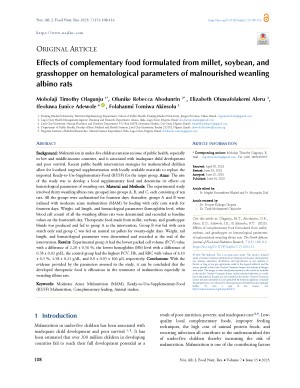Effects of complementary food formulated from millet, soybean, and grasshopper on hematological parameters of malnourished weanling albino rats
Abstract
Background: Malnutrition in under-five children remains an issue of public health, especially in low and middle-income countries, and is associated with inadequate child development and poor survival. Recent public health intervention strategies for malnourished children allow for localized targeted supplementation with locally available materials to replace the imported Ready-to-Use-Supplementary-Food (RUSF) for the target group. Aims: The aim of the study was to develop a local supplementary food and determine its effects on hematological parameters of weanling rats. Material and Methods: The experimental study involved thirty weanling albino rats, grouped into groups A, B, and C, each consisting of ten rats. All the groups were acclimatized for fourteen days, thereafter, groups A and B were induced with moderate acute malnutrition (MAM) by feeding with only corn starch for fourteen days. Weight, tail length, and hematological parameters (hemoglobin level, white blood cell count) of all the weanling albino rats were determined and recorded as baseline values on the fourteenth day. Therapeutic food made from millet, soybean, and grasshopper blends was produced and fed to group A as the intervention, Group B was fed with corn starch only and group C was fed on normal rat pellets for twenty-eight days. Weight, tail length, and hematological parameters were determined and recorded at the end of the intervention. Results: Experimental group A had the lowest packed cell volume (PCV) value with a difference of 2.20 ± 0.56 %, the lowest hemoglobin (Hb) level with a difference of 0.58 ± 0.02 g/dL, the control group had the highest PCV, Hb, and RBC with values of 4.10 ± 0.5 %, 1.58 ± 0.21 g/dL, and 0.9 ± 0.05 x 106 µ/L respectively. Conclusions: With the evidence provided by the parameters assessed in the study, it can be concluded that the developed therapeutic food is efficacious in the treatment of malnutrition especially in weanling albino rats.
Keywords: Moderate Acute Malnutrition (MAM), Ready-to-Use-Supplementary-Food (RUSF) Malnutrition, Complementary feeding, Animal studies.
Full text article
Authors
Copyright (c) 2023 Mobolaji Timothy Olagunju, Olunike Rebecca Abodunrin, Elizabeth Oluwafolakemi Aleru, Ifeoluwa Eunice Adewole, Folahanmi Tomiwa Tomiwa

This work is licensed under a Creative Commons Attribution 4.0 International License.
-
Attribution — You must give appropriate credit, provide a link to the license, and indicate if changes were made. You may do so in any reasonable manner, but not in any way that suggests the licensor endorses you or your use.
-
No additional restrictions — You may not apply legal terms or technological measures that legally restrict others from doing anything the license permits.





